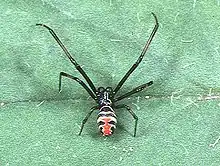Latrodectus elegans
Latrodectus elegans is a species of black widow spider,[2][3][4][5] found in South Asia, Southeast Asia and East Asia. It was first collected by the Swedish arachnologist Tamerlan Thorell in the Karen Hills in Myanmar, but is also found in Thailand,[6] India, Nepal, Vietnam, China and Japan.[7] As of July 2022, the World Spider Catalog lists only India, Nepal, Myanmar, China and Japan.[1] This species has been recorded in India and Nepal only since 2012, and Indochina in 2015,[8] which is thought to reflect historical under-surveying of arachnids in this region.[9]
| Latrodectus elegans | |
|---|---|
 | |
| Male | |
 | |
| Female | |
| Scientific classification | |
| Domain: | Eukaryota |
| Kingdom: | Animalia |
| Phylum: | Arthropoda |
| Subphylum: | Chelicerata |
| Class: | Arachnida |
| Order: | Araneae |
| Infraorder: | Araneomorphae |
| Family: | Theridiidae |
| Genus: | Latrodectus |
| Species: | L. elegans |
| Binomial name | |
| Latrodectus elegans | |
In 2022 a chromosome-scale reference genome was sequenced from specimens from Yunnan, producing a 1.57 Gb sized genome with 14 chromosomes. Annotating this there were found to be 20,167 protein-coding genes, including 55 toxin and 26 spidroin (spider silk) genes.[10]
References
- "Taxon details Latrodectus elegans Thorell, 1898". World Spider Catalog. Natural History Museum Bern. Retrieved 2022-07-30.
- Ushkaryov YA, Volynski KE, Ashton AC (April 2004). "The multiple actions of black widow spider toxins and their selective use in neurosecretion studies". Toxicon. 43 (5): 527–542. doi:10.1016/j.toxicon.2004.02.008. PMID 15066411.
- Sari I, Zengin S, Davutoglu V, Yildirim C, Gunay N (June 2008). "Myocarditis after black widow spider envenomation". The American Journal of Emergency Medicine. 26 (5): 630.e1–630.e3. doi:10.1016/j.ajem.2007.09.012. PMID 18534303.
- "Latrodectus elegans Thorell, 1898". Integrated Taxonomic Information System. Retrieved 14 October 2012.
- "Latrodectus elegans Thorell, 1898". World Spider Catalog. American Museum of Natural History. Retrieved 14 October 2012.
- Kananbala A, Manoj K, Bhubaneshwari M, Binarani A, Siliwal M (2012). "The first report of the widow spider Latrodectus elegans (Araneae: Theridiidae) from India". Journal of Threatened Taxa. 4 (7): 2718–22. doi:10.11609/jott.o3152.2718-22.
- Nieuwenhuys E. "The demystification of the toxicity of spiders".
- Košulič O, Mašová S (2015). "First record of the widow spider Latrodectus elegans Thorell, 1898 (Araneae, Theridiidae) from Indochina". Programme & Abstracts - 29th European Congress of Arachnology.
- Shrestha B, Dörr T (2020-07-26). "First records of the black widow spider Latrodectus elegans Thorell, 1898 (Araneae: Theridiidae) from Nepal". Journal of Threatened Taxa. 12 (10): 16385–16388. doi:10.11609/jott.5796.12.10.16385-16388. ISSN 0974-7907. S2CID 225493148.
- Wang Z, Zhu K, Li H, Gao L, Huang H, Ren Y, Xiang H (May 2022). "Chromosome-level genome assembly of the black widow spider Latrodectus elegans illuminates composition and evolution of venom and silk proteins". GigaScience. 11. doi:10.1093/gigascience/giac049. PMC 9154082. PMID 35639632.